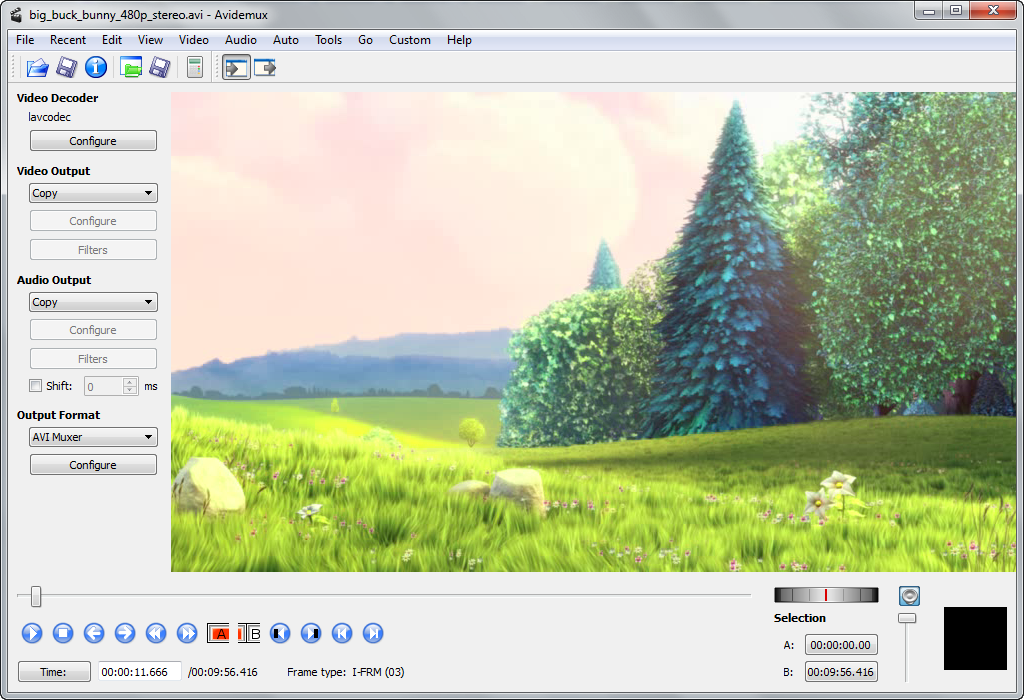

More than sufficient for my expectations, but I would not recommend going above 25. QuoteIf I do go with the software encoder, is the default quality setting of 20 sufficient, or what is the rule of thumb there?
#Avidemux source 720p
I chose 2000kbps as it allowed to achieve acceptable quality for 720p 25fps source video. What is considered a "high" bitrate? The default is 2000kbps (max 4000). QuoteMy questions- VideoToolbox encodes WAY WAY faster than the software encoder, as expected, so I would prefer to use this if possible. QuoteFrom what I understand, the software encoder quality setting under "rate control" dictates the level of compression/quality, and that 16-25 is a good range, with 16 being the upper limit for quality that we can perceive?įFmpeg wiki has a very good description of x264 CRF values: Obviously, any encoder will produce awful quality if you configure it to do so. they require higher bitrates) to achieve the same visual quality as x264.


Another post indicated that VideoToolbox can output higher quality at the expense of disk space compared to the software encoder.Īs a rule, hardware accelerated encoders achieve lower compression (i.e. QuoteFor encoding H.264 I see that there's the software encoder "MPEG4 AVC (x264)" and there's a hardware accelerated encoder "VideoToolbox". I am inclined to recommend to build current git master of Avidemux from source, which is pretty easy on macOS (albeit not completely trivial as on Linux) if you run Sierra or later. There haven't been any fresh macOS nightlies for quite a long time (the latest was generated on Nov 24). VLC reports the source video has an input and stream bitrate of around 15000kb/s. The tutorial has on H.264 has a lot of info but not sure what to focus on for my purposes since there's so much. I know my source video is already compressed and basically I want to preserve roughly the same level of quality as much as I can, and hopefully save some disk space as well if possible. If I do go with the software encoder, is the default quality setting of 20 sufficient, or what is the rule of thumb there? Are there any good rules of thumb to preserve quality without generating huge files? I find that when I set that to 3000kbps, it seems to match the output bitrate of the pure software encoded video of the same input file. My questions- VideoToolbox encodes WAY WAY faster than the software encoder, as expected, so I would prefer to use this if possible. From what I understand, the software encoder quality setting under "rate control" dictates the level of compression/quality, and that 16-25 is a good range, with 16 being the upper limit for quality that we can perceive? Another post indicated that VideoToolbox can output higher quality at the expense of disk space compared to the software encoder.
#Avidemux source 1080p
I'm just straight joining, cutting and re-encoding avi files that were originally encoded as 1080p MJPEG / PCM to hopefully save some disk space and take advantage of hardware acceleration on my Mac Mini 2012 (Core i5 dual-core).įor encoding H.264 I see that there's the software encoder "MPEG4 AVC (x264)" and there's a hardware accelerated encoder "VideoToolbox".
#Avidemux source mp4
I've settled on H.264 in an MP4 container, because I don't have subtitles or need for multiple audio tracks. Now, I'm a bit overwhelmed by the sheer number of settings available depending on the encoder.
#Avidemux source how to
It's take a bit of research for me to start to figure out how to get things to work, especially with the queue. Hi all- new to Avidemux and I'm impressed with how powerful this software is.


 0 kommentar(er)
0 kommentar(er)
